
A demonstration of the lissajous/halo orbit orbit to be used by the Queqiao Chang'e-4 relay satellite mission.
14.06.2018
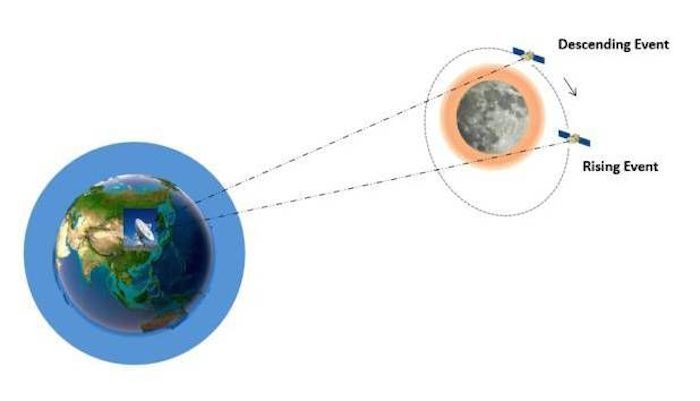
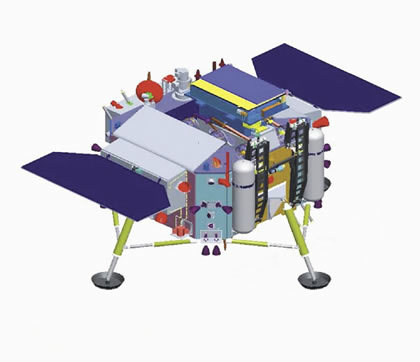
The relay satellite for the Chang'e-4 lunar probe, which is expected to land on the far side of the Moon at the end of the year, has entered the planned orbit, the China National Space Administration (CNSA) announced Thursday.
The satellite, named Queqiao (Magpie Bridge) and launched on May 21, entered the Halo orbit around the second Lagrangian (L2) point of the Earth-Moon system, about 65,000 km from the Moon, at 11:06 a.m. Thursday after a journey of more than 20 days.
"The satellite is the world's first communication satellite operating in that orbit, and will lay the foundation for the Chang'e-4, which is expected to become the world's first soft-landing, roving probe on the far side of the Moon," said Zhang Hongtai, president of the China Academy of Space Technology (CAST).
The concept of the Halo orbit around the Earth-Moon L2 point was first put forward by international space experts in 1950s.
While in orbit, the relay satellite can see both the Earth and the far side of the Moon. The satellite can stay in the Halo orbit for a long time due to its relatively low use of fuel, since the Earth's and Moon's gravity balances the orbital motion of the satellite.
"From Earth, the orbit looks like a halo of the Moon, which is where it got its name," said Zhang Lihua, project manager of the relay satellite.
He said the Halo orbit was a three-dimensional irregular curve. It is extremely difficult and complex to maintain the satellite in orbit.
"If there is a tiny disturbance, such as gravitational disturbance from other planets or the Sun, the satellite will leave orbit. The orbit period is about 14 days. According to our current plan, we will conduct orbit maintenance every seven days," Zhang said.
"Queqiao is like a little kid running wild in orbit. If there's even the slightest negligence by controllers on the ground, the satellite will be lost forever," said Guan Bin, a designer for the satellite's control system.
"It's a new type of orbit, we don't have any experience. We ran a number of simulations to make sure the design is feasible and reliable," Zhang said.
In order to set up a communication link between Earth and the planned Chang'e-4 lunar probe, space engineers must keep the satellite stable and control its altitude, angle and speed with high precision.
Next, the team will test the communication function of the relay satellite.
Weighing about 400 kg and with a designed life of three years, the satellite carries several antennas. One, shaped like an umbrella with a diameter of 4.2 meters, is the largest communication antenna ever used in deep space exploration, said Chen Lan, deputy chief engineer of the Xi'an Branch of CAST.
Tidal forces of the Earth have slowed the Moon's rotation to the point where the same side always faces the Earth, a phenomenon called tidal locking. The other face, most of which is never visible from Earth, is the far side or dark side of the Moon, not because it's dark, but because most of it remains unknown.
With its special environment and complex geological history, the far side is a hot spot for scientific and space exploration. The Aitken Basin of the lunar south pole region on the far side has been chosen as the landing site for Chang'e-4. The region is believed to have great research potential.
However, landing and roving require a relay satellite to transmit signals. Establishing a communication link is essential for the success of the Chang'e-4 mission.
The relay satellite is also equipped with a low-frequency radio spectrometer developed by Dutch scientists to help scientists "listen" to the deeper reaches of the cosmos.
A lunar optical imaging detector developed by Saudi Arabia is installed on a micro satellite launched together with Queqiao.
The lander and rover of Chang'e-4 will be equipped with instruments developed by Germany and Sweden. China's lunar exploration program will be a new research platform for scientists around the world.
To raise interests of the public in space exploration, the Lunar Exploration and Space Program Center of the CNSA has invited people to write down their hopes for lunar and space exploration, and the relay satellite carries the names of about 100,000 participants and their hopes into deep space.
Quelle: Xinhua
---
Update: 18.06.2018
.
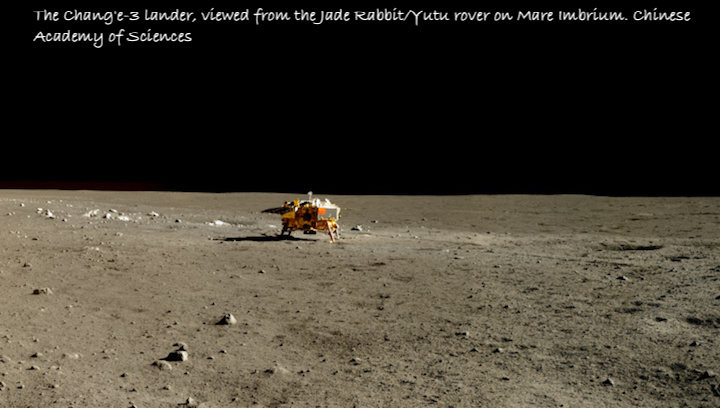
China is planning to launch its Chang'e-4 lander and rover spacecraft to the far side of the Moon in December, a top scientist in the country's lunar exploration programme has said.
Wu Weiren, a chief designer of the China Lunar Exploration Project (CLEP), told Chinese state media that following the arrival of a prerequisite communications relay satellite in a special orbit beyond the Moon, the focus is now on preparations for the landing portion of the pioneering Chang'e-4lunar far side mission.
"Now our focus is to ensure that the Chang'e-4 lunar probe's successful launch and we initially scheduled the launch in December," Wu told CCTV+.
"We will use Changzheng-3B rocket to launch, so now the tests of technical conditions and assembling are still underway," Wu, also an academician with Chinese Academy of Engineering, added.
The rocket to carry the lander and rover, also known as the Long March 3B, will lift off from the Xichang Satellite Launch Centre in Sichuan Province in the southwest of the country.
Chang'e-4 is the backup to the Chang'e-3 Moon landing mission that put the Yutu (Jade Rabbit) rover on Mare Imbrium on the near side of the Moon in late 2013, marking the first soft lunar landing since 1976.
It has been repurposed to make the first ever attempt at a soft landing on the far side of the Moon. Such a mission is very challenging as the lunar far side never faces the Earth due to tidal locking, meaning a special satellite is required to facilitate communications.
The Queqiao relay satellite was successfully inserted into a complex Lissajous orbit at the second Earth-Moon Lagrange point (EML2) on Thursday following its launch on May 20.
The orbit around the EML2 location allows the Queqiao satellite to have line-of-sight with both tracking stations on the ground and the far side of the Moon simultaneously.

A demonstration of the lissajous/halo orbit orbit to be used by the Queqiao Chang'e-4 relay satellite mission.
Queqiao will now undergo on-orbit testing of its communications functions, for which it carries a 4.2-metre parabolic antenna.
Also aboard the 448 kg satellite is the Netherlands-China Low-Frequency Explorer (NCLE), developed by Radboud University and others, will attempt to detect a low frequency signal from the ‘dark ages’ of the universe.
The lander and rover in March went through thermal vacuum tests — the last of a range of space environment tests which began in January — which the Chang'e-4 spacecraft need to pass before they can leave the Assembly, Integration and Testing (AIT) Centre.
Thermal vacuum testing simulates the extreme ranges of hot and cold temperatures to be experienced by the spacecraft on its mission.
Temperatures on the Moon's surface can reach up to around 120 degrees Celsius during sunlight, and as low as -170 degrees Celsius during the lunar nights.
The harsh lunar environment also poses other challenges, including fine, abrasive dust, which Brian O'Brien, adjunct Professor at the University of Western Australia, believes was the cause of the immobilisation of China's Yutu rover in January 2014.

A photo of Yutu (Jade Rabbit) taken by the Chang'e-3 lander in December 2013 on the surface of the Moon.
Despite the mobility issue with Yutu, which saw it travel just 114 metres before suffering an anomaly, Chang'e-3 brought fascinating science discoveries, including a new kind of rock and lunar layers.
Its ultraviolet telescope was, last we knew, still operational on the lander and could continue to work for decades, while the cameras from both spacecraft returned astounding images from Mare Imbrium.

A view of Mare Imbrium taken by China's Chang'e-3 mission.
The landing area will be within the scientifically intriguing South Pole-Aitken Basin, a huge impact crater on the far side of the Moon, which could contain exposed lunar mantle. While some candidates including the Von Kármánimpact crater have been noted, the precise landing site has not been publicly released.
The lander will carry a Landing Camera (LCAM), Terrain Camera (TCAM), Low Frequency Spectrometer (LFS), and a payload developed in Germany, the Lunar Lander Neutrons and Dosimetry (LND),
The rover will be equipped with a Panoramic Camera (PCAM), a Lunar Penetrating Radar (LPR) similar to that on Yutu, and a Visible and Near-Infrared Imaging Spectrometer (VNIS). The final payload, developed by the Swedish Institute of Space Physics (IRF) in Kiruna is the Advanced Small Analyser for Neutrals (ASAN).
Together, the two segments of the Chang'e-4 mission carry four international payloads, including NCLE on Queqiao and a camera made in Saudi Arabia carried aboard the Longjiang-2 lunar microsatellite, which last week returned stunning images from lunar orbit.

The Earth and Moon imaged on June 8 by the KACST-developed camera on China's Longjiang-2/DSLWP-B microsatellite. The image shows Saudi Arabia on the distant Earth, as well as the northern hemisphere of the lunar far side, near Petropavlovskiy crater.
Chang'e-3 and Chang'e-4 form the second phase of China's original lunar exploration project, which kicked off in the early 2000s.
The orbiting phase was completed by Chang'e-1 (2007) and backed up by Chang'e-2 (2010). The third and final phase will be sample returns, first with Chang'e-5 in 2019, should the Long March 5 rocket be proven ready for flight later this year.
Beyond this, China is planning to expand its sights to the polar regions of the Moon, with the aim of establishing a 'research station' through a series missions across the next decade.
Crewed missions to the Moon could begin in the 2030s, following the development of a new crewed spacecraft and the Long March 9, a super-heavy-lift launch vehicle comparable to the Saturn V which sent NASA's Apollo missions to the Moon.

The Moon's south pole from images taken by the 1994 NASA Clementine mission.
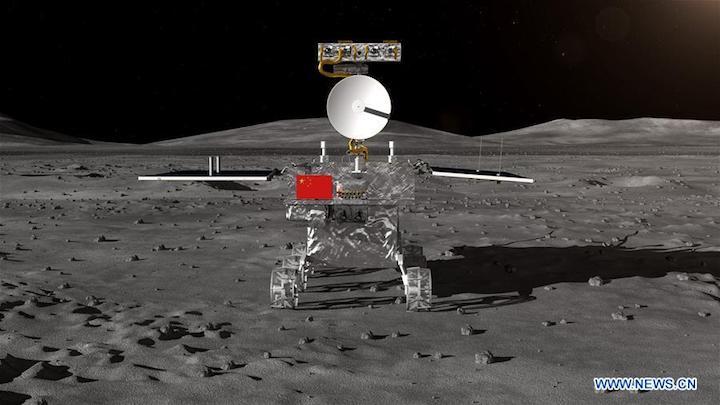
Photo provided by State Administration of Science, Technology and Industry for National Defense shows the image of the rover for China's Chang'e-4 lunar probe. China's moon lander and rover for the Chang'e-4 lunar probe, which is expected to land on the far side of the moon this year, was unveiled Wednesday. The global public will have a chance to name the rover. (Xinhua)
BEIJING, Aug. 15 (Xinhua) -- China's moon lander and rover for the Chang'e-4 lunar probe, which is expected to land on the far side of the moon this year, was unveiled Wednesday.
Images displayed at Wednesday's press conference showed the rover was a rectangular box with two foldable solar panels and six wheels. It is 1.5 meters long, 1 meter wide and 1.1 meters high.
Wu Weiren, the chief designer of China's lunar probe program, said the Chang'e-4 rover largely kept the shape and conditions of its predecessor, Yutu (Jade Rabbit), China's first lunar rover for the Chang'e-3 lunar probe in 2013.
However, it also has adaptable parts and an adjustable payload configuration to deal with the complex terrain on the far side of the moon, the demand of relay communication, and the actual needs of the scientific objectives, according to space scientists.
Like Yutu, the rover will be equipped with four scientific payloads, including a panoramic camera, infrared imaging spectrometer and radar measurement devices, to obtain images of moon's surface and detect lunar soil and structure.
It will also endure vacuum, intense radiation and extremes of temperature. The moon has a large temperature difference between day and night, which can reach more than 300 degrees Celsius.
Both the lander and rover will carry international payloads for other countries.
The Chang'e-4 lunar probe will land on the Aitken Basin of the lunar south pole region on the far side of the moon, which is a hot spot for scientific and space exploration.
Direct communication with the far side of the moon, however, is not possible, which is one of the many challenges for the Chang'e-4 lunar probe mission.
China launched a relay satellite, named Queqiao, in May, to set up a communication link between the Earth and Chang'e-4 lunar probe.
The global public will have a chance to name the rover, according to State Administration of Science, Technology and Industry for National Defense.
Participants can submit their proposed names for the rover through the internet from Aug. 15 to Sept. 5, and the official name will be announced in October after several selection rounds.
Winners will be rewarded at most 3,000 yuan and invited to watch the lunar probe launch.
The name Yutu was chosen from 200,000 proposals submitted over two months worldwide.
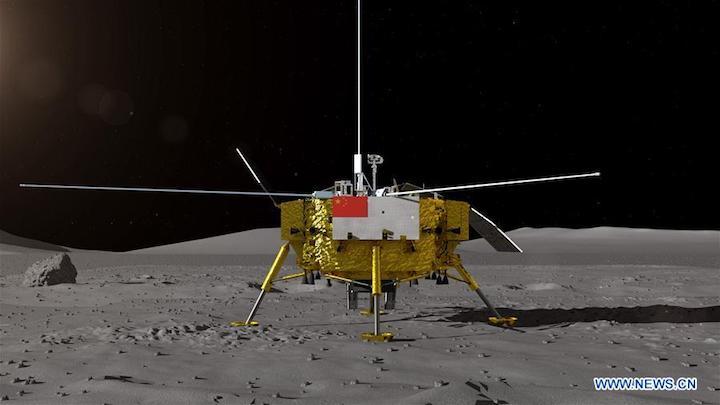
Photo provided by State Administration of Science, Technology and Industry for National Defense shows the image of the moon lander for China's Chang'e-4 lunar probe. China's moon lander and rover for the Chang'e-4 lunar probe, which is expected to land on the far side of the moon this year, was unveiled Wednesday. The global public will have a chance to name the rover. (Xinhua)
Quelle: Xinhua
---
Update: 20.09.2018
.
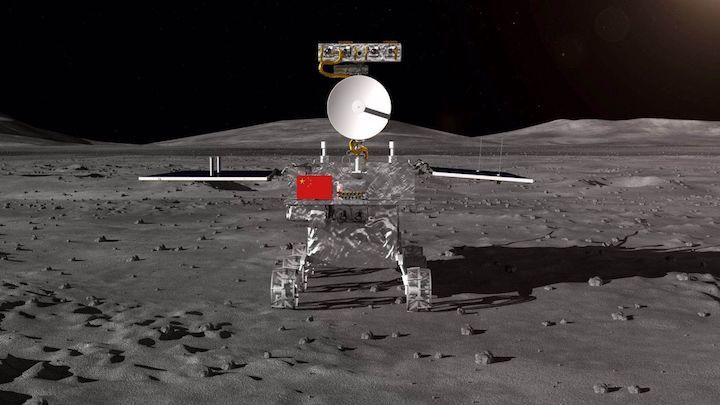
A render of China's Chang’e-4 moon rover that is expected to land on the far side of the Moon around December 2018. CNSA
A shortlist of ten names has been revealed for the Chang'e-4 lunar far side rover following a public call and contest to solicit names for the pioneering Moon mission.
Chang'e-4 is a repurposed backup to the 2013 Chang'e-3 lander and rover which soft-landed on the near side of the Moon.
The mission will make the first ever attempt at landing on the far side of the Moon, which never faces the Earth, following launch in December this year.
The China National Space Administration (CNSA) opened a public competition in August to give a name to the mission rover, just as it did for Chang'e-3, which saw it named Yutu (玉兔, or 'Jade Rabbit'), the animal companion to the mythological Chinese goddess of the Moon, after which the Chinese robotic lunar missions are named.
The ten shortlisted names are:
逐梦 - Zhu Meng (chasing the dream, dream catching)
光明 - Brightness
玉兔二号 - Yutu II (Jade Rabbit 2)
探索 - Exploration
征途 - Expedition
精灵 - Genius (Fairy or elf)
无畏 - Fearless
望舒 - Wang Shu (a god that drives for the Moon in Chinese mythology; also can be used to refer to the Moon)
行者 - Stroller or Hiker
金兔 - Golden Rabbit
Voting is now open until October 10, after which a final review will take place, followed by announcement of the result in late October.
The contest generated over 40,000 entries according to Xinhua (Chinese), with the oldest entrant being 94-years-old and the youngest aged 7.
Launch of Chang'e-4 will take place at the Xichang Satellite Launch Centre in December, with a Long March 3B rocket to send the spacecraft into trans-lunar injection.

The Chang'e-4 lander undergoing testing.
In May a satellite named Queqiaowas launched towards a special point beyond the Moon, at which it entered a halo orbit that allows it to have line-of-sight with both the Earth and far side of the Moon at all times and thus act as a communications relay for the Chang'e-4 mission.
The lander and rover will target a landing within the South Pole-Aitken Basin, a huge and scientifically significant impact crater on the far side of the Moon. The Von Kármán crater is understood to be the destination, within which the spacecraft with deploy and use a number of scientific instruments.
Chang'e-4 lander and rover will also carry cameras similar to those used by Chang'e-3 to return astounding images from Mare Imbrium, a vast lava plain within the Imbrium Basin on the Moon.
See our Chang'e-4 feature for the latest news and background on the lunar far side mission.

A view of the landing area of the Chang'e-3 lander on Mare Imbrium, taken by the Lander Terrain Camera (TCAM).